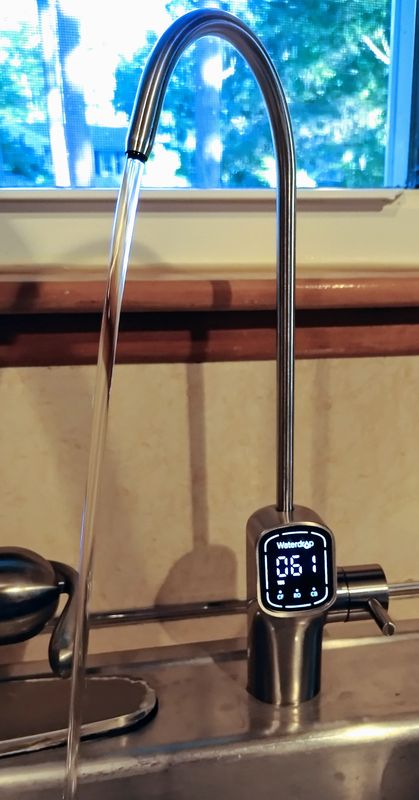
REVIEW – As water testing becomes more sensitive and regulations become more stringent, people look to ensure they are drinking contaminant-free water. The Waterdrop G3P800 is a water filter that uses reverse osmosis and UV to treat up to 800 gallons per day. I have one to review. Read on to see what I think!
What is it?
The Waterdrop G3P800 reverse osmosis tankless water filter is a high-capacity, high-flow, under-sink water filtration system designed to remove contaminants from municipal drinking water. The system is automated to draw water from the cold faucet connection and purify the water on-demand by filtering through a pre-sediment and carbon block filter, a reverse osmosis membrane filter, an activated carbon polishing filter, and a UV sterilizer. The filters are installed in an under-sink housing that conceals the internal piping connections between the filters and also contains the system electronics, a local operation display, and a booster pump. The water is dispensed through a faucet that has a local display of the filter health and total dissolved solids (TDS) measured at the outlet of the system.
What’s in the box?
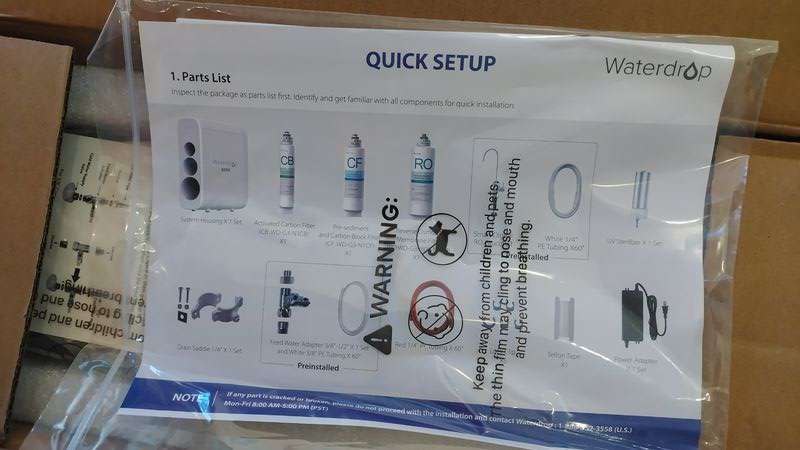
- System Housing
- Activated Carbon Filter
- Pre-Sediment and Carbon Block Filter
- Reverse Osmosis Membrane Filter
- Smart Digital RO Faucet
- White faucet tubing
- UV sterilizer
- Feed water adapter
- White Supply tubing
- Drain Saddle
- Red Waste tubing
- Power adapter
- Teflon tape
- lock clips
Hardware specs
- Filter capacity – 800 gallons per day (GPD)
- Filtering rate – 1 cup / 6 seconds
- Activated carbon filter life – up to 12 months or 1600 gallons
- Pre-Sediment and Carbon Block Filter – up to 6 months or 800 gallons
- Reverse Osmosis Membrane Filter – up to 24 months or 3200 gallons
- under-sink unit size18.12″x 5.67″x17.72″
- feed water pressure requirements 14.5-87 psi
- feed water temperature requirements 41-100ºF
- feed water quality requirements – municipal tap water
- max daily production rate – 800 GPD
- power specification – 100-240 VAC, 2.5 Amps, 50-60 Hz
Design and features
Unboxing

The Waterdrop G3P800 reverse osmosis tankless water filter comes in a large brown box that is roughly 22″x25″x9″. The box has a picture of the unit on the sides. Inside everything is neatly packed in a styrofoam form.
Installation
Note that the box does not include everything that you will need to install the water filter. You will or may also need
- variable speed drill
- utility knife or scissors
- 1/2″ drill bit for drainpipe and 1″ bit for faucet hole
- adjustable wrench and or pliers
- flashlight
- towel
- screwdriver
Note that the location where this is installed should have an accessible electrical receptacle and the cabinet should be at least 20″ in depth, 18″ in height, and about 9″ in width. Also recognize that the front of the unit needs to be accessible to remove and replace the filters, the largest of which is 15″ long. It is recommended that the unit be installed free-standing so that vibrations are not transferred to the counter when the unit is operating. In order to use the drain saddle a 1″ drain pipe needs to be accessible in the install location.
Also, When the Waterdrop G3P800 reverse osmosis tankless water filter is functioning normally it will automatically waste about 25% of the water that is fed to it. This seems high but industrial RO systems can reject even more (>40%) water and this does not include the water that may be used for backwashing filters and for sanitization of carbon beds. The Waterdrop G3P800 will automatically wash the filters to the waste line in order to maintain sanitary conditions and keep the filters operating efficiently for as long as possible. If you are considering using water that is in limited supply (RV for instance) this may not be the best-suited technology and normal filtration may be a more appropriate technology.
The installation steps are pretty straightforward.
1. The directions start with plumbing but it may be advantageous to investigate where everything is going to go first and to see how the system will fit together.
2. A feedwater adapter is installed above the cold water supply shut-off valve.
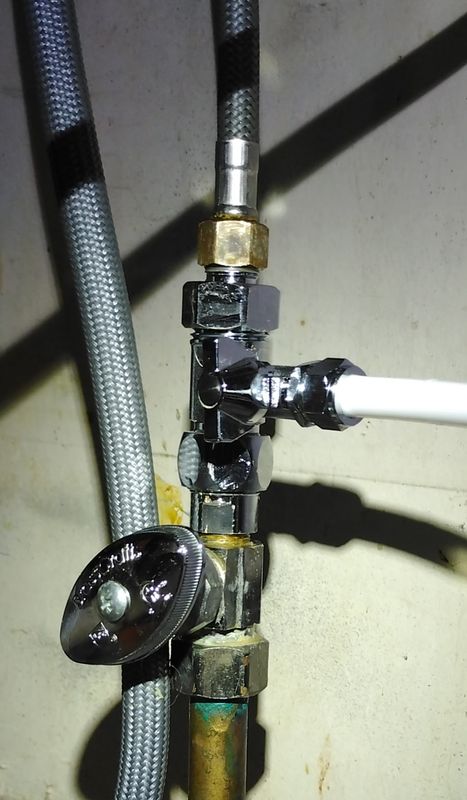
The adapter is 1/2″ and comes with bushings to adapt to a 3/8″ supply as well. I happen to have a reducing valve installed in my kitchen so I used the supplied bushing.
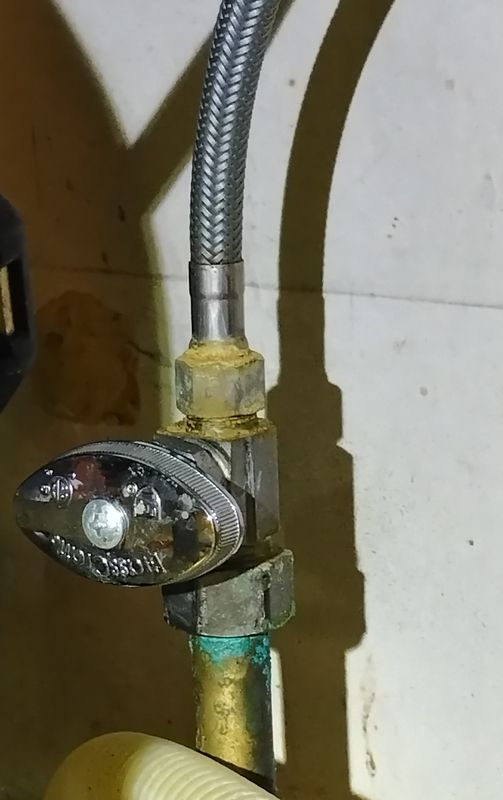
3. The RO faucet is installed. I had a soap dispenser in my sink already so I removed it and used the hole for the faucet.
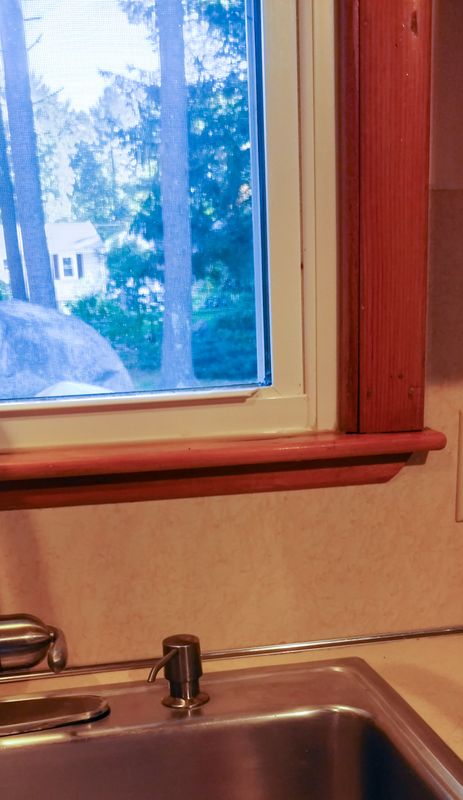
The hole is a little bigger than 1″ but it is smaller than the base of the faucet so it works well. If you don’t have a hole in your counter, Waterdrop recommends that you watch a youtube video first for your particular situation (granite, quartz, stainless, ceramic, etc.) After installing the faucet the PE tubing is cut to install the UV lamp hanging below the line to the faucet.
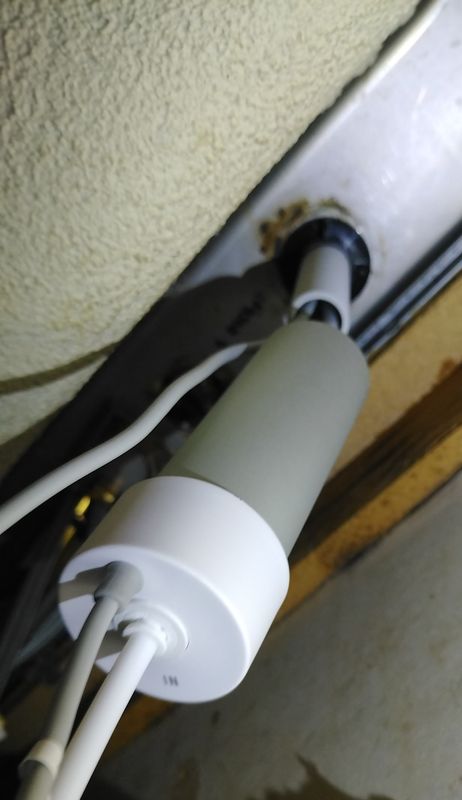
4. The drain saddle is installed. The directions do not explicitly state this but the saddle should go between the drain of the sink and the plug at the base of the P trap (the u-bend portion of the sink).
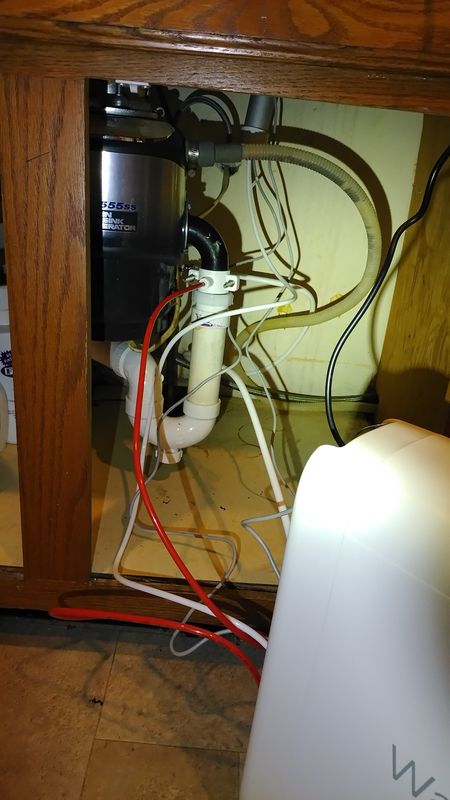 I only had a 1″ line coming out of my disposal so I mounted the line there. It is in the vertical position so backups are unlikely.
I only had a 1″ line coming out of my disposal so I mounted the line there. It is in the vertical position so backups are unlikely.
5. Install the tubing, electrical connections, and power into the system in a way that allows the system tubing to be inspected afterward. The tubing can be cut to length if needed.
6. Position the system into the final location. Check for leaks.
7. Install the filters. Check for leaks.
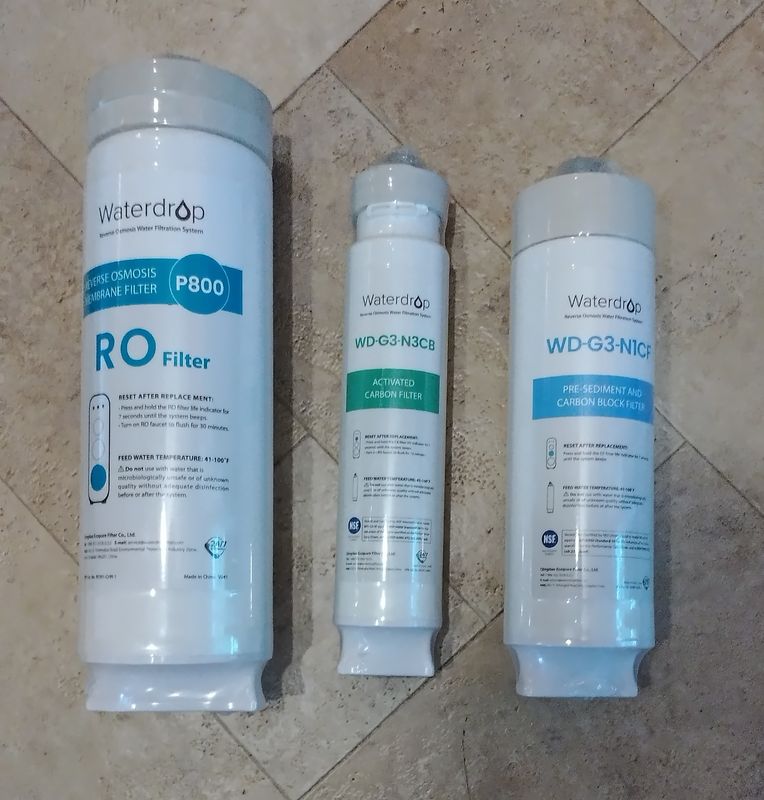
8. Power on the system
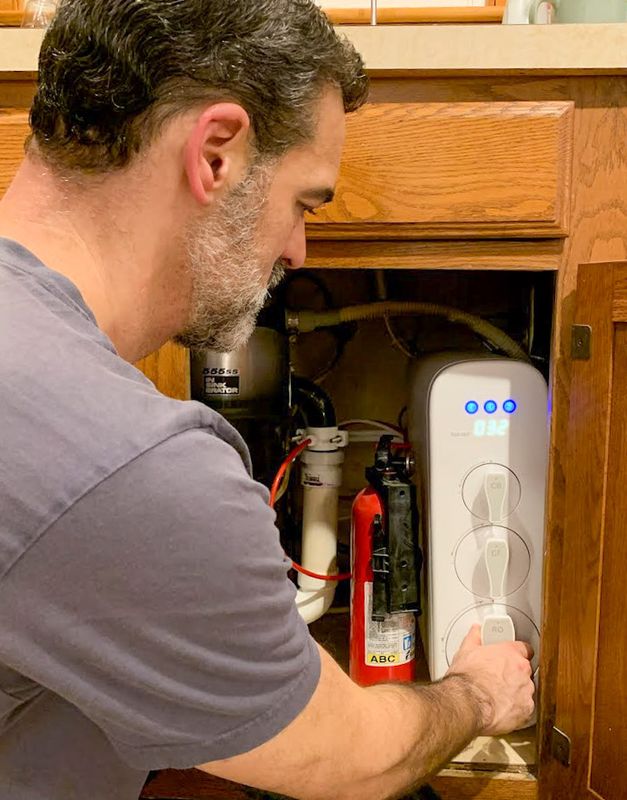
There are a couple of other options available with the Waterdrop G3P800 reverse osmosis tankless water filter. If this is going to be used with a refrigerator or other appliance, Waterdrop sells a small pressure tank that can boost the pressure delivery of water to the RO faucet and refrigerator. If you prefer the taste of mineral water, or want to ensure that there are adequate minerals in the water, a remineralization filter is also available for purchase. Note that this filter can be used just before the faucet on any water source to provide mineral content.
Operation
On start-up, the system will flush automatically for 5 minutes to the waste line. Flushing has this cool graphic on the system housing and the RO faucet that looks like a waterfall.
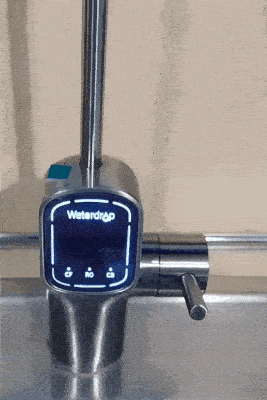
After the 5-minute flush, the RO faucet should be opened and the water should flow through the faucet for a cumulative 30 minutes. During this time the water is not drinkable (the water quality may be worse than the inlet water quality as the membranes are washed of debris). After a cumulative 30 minutes of flow through the faucet, the TDS level will be displayed and the system is now fully operational.
Both the front of the system housing and the display on the RO faucet shows the TDS measurement. The TDS measurement is based on the conductivity of the water with some conversion factors thrown in. In general, TDS, or more specifically conductivity, is a good measure to determine if RO is working effectively. A well-operated RO system will generally reduce the conductive ions in the water and since the conductive ions are usually smaller than most of the other contaminants that are also targeted then, therefore, the harmful contaminants are removed as well. Note that the water is not deionized and is still safe to drink even though it is passed through a RO membrane.
The UV lamp operation is indicated by a glowing ring around the UV device. The UV technology is LED based but I think that this is a separate blue LED rather than leakage from a light trap. LED UV technology has a longer life and less power consumption than mercury vapor technology lamps. The UV lamp is a great way to be absolutely sure no microorganisms are in the water and the Waterdrop G3P800 is one of the few systems that include this technology out of the box.
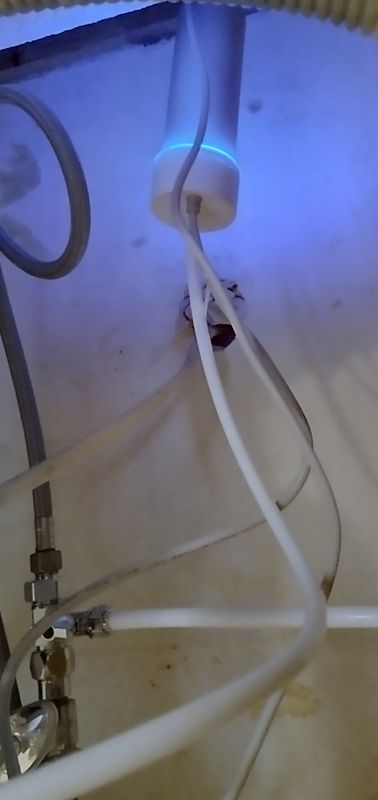
The RO faucet handle can modulate the flow of water to some extent but I usually open it all the way to get water flowing as quickly as possible. The maximum flow rate is about a glass of water every 6 seconds. This equates to 900 GPD but the system has mandatory flushes and filter replacements that limit the maximum daily capacity to 800 GPD.
The Faucet and system housing have reminders when it is time to change the filters. The color of the filter icon on the system housing and the RO faucet will change to yellow when there are 15 days or 40 gallons remaining and the icon will change to red when the system is expired. The system housing will beep twice when dispensing water with a yellow icon and will beep continuously when dispensing water with a red icon. Daily use of about 70 cups a day will consume the filter capacities before the time expires on each of their uses. At this rate, the filter indicator will turn yellow about 9 days before it expires.
When it comes time to change the filters on the Waterdrop G3P800 reverse osmosis tankless water filter, the process is fast and easy. The filters are like the type that is installed in most refrigerators. They are pushed into the unit and then they are secured with a half turn of the filter. If any of the filters, sensors or booster pump is leaking there is a catchbasin inside the unit with an integral leak detection circuit. Pressing the system housing indicator of the replaced filter for 7 seconds resets the filter use counter for the filter replaced.
If the system is not used for more than a week it is recommended that the RO faucet is opened, the cold water supply is closed, and the filters are removed and stored in the refrigerator.
Performance
My community has hard, low-quality tap water. After installing the Waterdrop G3P800, I can really tell the difference between the tap water and the RO water from the Waterdrop. I think that it tastes better than some of the bottled water I have tried. I have noticed that my daily water consumption has increased substantially with the constant availability of high-quality water.
I have an inexpensive TDS meter that I bought from Amazon. The meter shows about a 90% reduction in the TDS even though the values are different from the values displayed on the housing or the faucet.
The water is at the same temperature as the cold supply of our house or maybe a little warmer. The under-sink location of the housing is adjacent to the dishwasher, the disposal, and the PVC drainpipe. These items are all potentially heat generating and the low flow rate of the cold water through the system may cause a small rise in temperature.
The booster pump makes a low drone sound when operating. It is not loud, but it is noticeable.
What I like
- High flow rate for RO system
- Easy to install
- Informative faucet
- Complete with UV sterilization system
What I’d change
- High upfront cost
Final thoughts
The Waterdrop G3P800 reverse osmosis tankless water filter has a high upfront cost but bottled water can be expensive too. A store-brand bottle of water can be as little as $0.97 per gallon, so the costs for bottled water and this system are about the same for the first 800 gallons (6060 bottles). On average the system costs $165 a year in filter upkeep, or about the cost of 1300 bottles. So if the system is used to its capacity, on an average year this system will only cost about 25% of the cost of using water bottles. Not only does this system save money and plastic, but having good drinking water at the turn of a faucet is something everyone should have. If you’d like state-of-the-art RO-filtered water pick up a Waterdrop G3P800 system today!
Price: $999.00
Where to buy: Waterdrop (use code: ROSYSTEMG3P800 to save $199) or Amazon
Source: The sample of this product was provided by Waterdrop.



Gadgeteer Comment Policy - Please read before commenting
Just confirmed with Waterdrop customer rep that: 1) the g3p800 user manual is incorrect in stating CF filter life is up to 6 months or 800 gallons–it is actually only good for up to 550 gallons (a 1.5 gallon per day discrepancy in the wrong direction!); CB filter only 1200 gallons not 1600; and membrane filter only 2200 not 3200. Says he’s made a note of it. Also Black Friday discount code for $300 off $1000 purchase can’t be combined with the one you proved here for $199 off. Supposedly, Amazon will start offering 30% off tomorrow 11/21/2022) and they are offering a more generous return policy from date of purchase through January 31, 2023.
Helpful review nonetheless. thanks!
*provided (not proved!)
You forgot to mention, the filter flushes for 1 minute every time you turn on the faucet (after 5 minutes). That’s flushing 0.26gallons or 1.2 liters every time after you dispense. Unless you dispense in large quantities, you’ll end up wasting more than you consume.